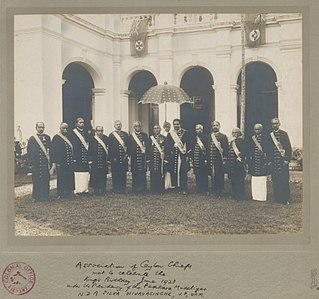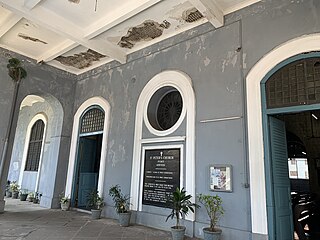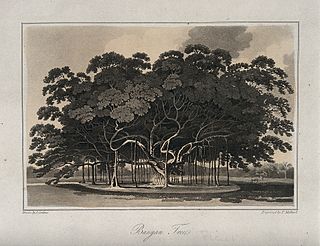Related Research Articles

Karava is a Sinhalese speaking ethnic group of Sri Lanka, whose ancestors migrated throughout history from the Coromandel coast, claiming lineage to the Kaurava royalty of the old Kingdom of Kuru in Northern India. The Tamil equivalent is Karaiyar. Both groups are also known as the Kurukula.

Mudaliyar was a Ceylonese colonial title during Portuguese and British rule of the island. Stemming from the native headman system, the title was usually hereditary, made to wealthy influential families loyal to the British Crown.

Galle Face is a 5 ha ocean-side urban park, which stretches for 500 m (1,600 ft) along the coast, in the heart of Colombo, the financial and business capital of Sri Lanka. The promenade was initially laid out in 1859 by Governor Sir Henry George Ward, although the original Galle Face Green extended over a much larger area than is seen today. The Galle Face Green was initially used for horse racing and as a golf course, but was also used for cricket, polo, football, tennis, and rugby.

Beruwala is a large town in Kalutara District, Western Province, Sri Lanka, governed by an Urban Council. The town covers a total area of approximately 15 km2 (5.8 sq mi) and is located on the south-west coast of Sri Lanka, 60 km (37 mi) south of Colombo.

Frederick North, 5th Earl of Guilford,, styled The Honourable Frederick North until 1817, was a British politician and colonial administrator.

Charles Henry de Soysa Dharmagunawardana Vipula Jayasuriya Karunaratna Disanayaka popularly known as Charles Henry de Soysa, JP was a Ceylonese entrepreneur and philanthropist. He was a pioneering planter, industrialist and was the wealthiest Ceylonese of the 19th century. He was instrumental in the establishment of the first Ceylonese bank, the Moratuwa carpenters guild, the Ceylon Agricultural and National Associations. He is widely regarded as the greatest philanthropist of the island for contributions which includes the De Soysa Maternity Hospital, the Prince and Princess of Wales Colleges, the Model Farm Experimental Station and many other institutions and acts of charity, establishing infant-maternal healthcare and secular education for girls in the country. He would have been the island's first Knight Bachelor, but having died prior, his widow was given the rare honor of the use of the style and dignity of wife of the Knight Bachelor and was known as Catherine, Lady de Soysa.
President's House is the official residence and workplace of the President of Sri Lanka, located at Janadhipathi Mawatha, Colombo, Sri Lanka. Since 1804 it had been the residence of British Governors and Governors-General and was known as the "King's House" or the "Queen's House" until Sri Lanka became a republic in 1972.
Ambalangoda is a coastal town located in Galle District, Southern Province of Sri Lanka. Governed by Ambalangoda Urban Council, the town is famous for its ancient demon masks and devil dancers. Situated approximately 87 kilometres (54 mi) south of Colombo, it sits on an elevation of 13 metres (43 ft) above the sea level.
The Royal Asiatic Society of Sri Lanka (RASSL) is based in Colombo, Sri Lanka. It is one of the oldest learned societies in Sri Lanka with a history of over 160 years. It was established on 7 February 1845, paralleling the Royal Asiatic Society of Great Britain and Ireland to further oriental research as the Ceylon Branch of the Royal Asiatic Society. In 1977 it was renamed the Royal Asiatic Society of Sri Lanka.

The National Museum of Kandy in Kandy, Sri Lanka is located next to the Temple of the Tooth in part of the former Royal Palace of Kandy. The primary exhibits are housed in the Palle Vahala building, which was the former home of the King's harem. A secondary exhibition is located in the main palace building. The museum is maintained by the Department of National Museums.
George Turnour Jnr, CCS (1799–1843) was a British colonial administrator, scholar and a historian. A member of the Ceylon Civil Service, he served as a Government Agent, Assistant Colonial Secretary and Treasurer of the Colony. He is known for his translation of the Mahavamsa, the Great Chronicle of Sri Lankan history which was published in 1837. Along with James Prinsep and Captain Edward Smith, he began to decipher the inscriptions on the first discovered Pillar of Ashoka.

Royal College, Colombo is a selective entry boys' school located in Cinnamon Gardens, Colombo, Sri Lanka. Started by Rev. Joseph Marsh in 1835, it was established as the Colombo Academy by Sir Robert Wilmot-Horton in January 1836, as part of the implementation of the recommendations of the Colebrooke Cameron Commission (1833), and was the first government-run secondary school for boys in the island.

Johan Gerard van Angelbeek was a Dutch colonial officer who commanded Dutch forces on the island of Ceylon during the colony's final year in the Dutch Empire before its seizure by a British expeditionary force.
Arippu Fort was built by the Portuguese and was handed over to the Dutch in 1658. The small bastion fort is located in Arippu, which is 16 km (9.9 mi) away from Mannar Island. The fort is nearly square in shape, with two bastions.
John Leonard Kalenberg van Dort, commonly known as J. L. K. van Dort, was a 19th-century Ceylonese artist of Dutch Burgher descent.

The Hamilton Canal is a 14.5 km (9.0 mi) canal connecting Puttalam to Colombo, passing through Negombo in Sri Lanka. The canal was constructed by the British in 1802 and completed in 1804. It was designed to drain salt water out of the Muthurajawela wetlands. The canal was named after Gavin Hamilton, the Government Agent of Revenue and Commerce.

St. Peter's Church is one of the oldest continuously functioning churches in Colombo, Sri Lanka. It is located on Church Street in Colombo Fort, on the northern side of the Grand Oriental Hotel.
Alli Rani, also known as Alli arasi, is a legendary Tamil queen of the Sangam period, who is thought to have ruled the whole western and northern coast of Sri Lanka from her capital Kudiramalai. According to folklore, her fort, Allirani fort, is located in Mannar, Sri Lanka. She is sometimes seen as an incarnation or multiform of Meenakshi and Kannagi. Legends attribute her as an "Amazon" ruler, who had an administrative and an army of only women, with male being their subordinates and servants.

James Cordiner (1775–1836) was a Scottish Episcopal minister and writer, author of A Description of Ceylon.
George Vane CMG, CCS, was the thirteenth Treasurer of Ceylon (1865-1882), and a member of both the Legislative Council and Governor's Executive Council, under the Robinson, Gregory and Longden administrations.
References
- 1 2 3 Ganegoda, Ariyaratne (15 March 2013). "The Doric Bungalow in Arippu East". Ceylon Today. Retrieved 25 February 2015.
- 1 2 3 4 Chandrasena, Nimal (4 March 2012). "An ancient village, a ruin by the sea and stories of pearls from Taprobane". The Sunday Times. Retrieved 25 February 2015.
- 1 2 3 4 5 6 7 Wisumperuma, Dhanesh (2005). "The Doric at Arippu: Its Date and Identification". Journal of the Royal Asiatic Society of Sri Lanka. 51: 79–96. Retrieved 25 February 2015.
- ↑ Royal Asiatic Society of Great Britain and Ireland (1955). "Journal of the Ceylon Branch of the Royal Asiatic Society". 4–7. Colombo: Colombo Apothecaries Company: 133. Retrieved 20 February 2015.
{{cite journal}}: Cite journal requires|journal=(help) - ↑ Littell, E. (1836). "Museum of Foreign Literature, Science and Art: Journal of an excursion in Ceylon". United States Journal. 28: 255. Retrieved 25 February 2015.
- ↑ Cordiner, James (1807). A Description of Ceylon, Volume 1. Longman, Hurst, Rees, and Orme. p. 37.
- ↑ Handbook for the Ceylon Traveller. Studio Times. 1974. p. 141.